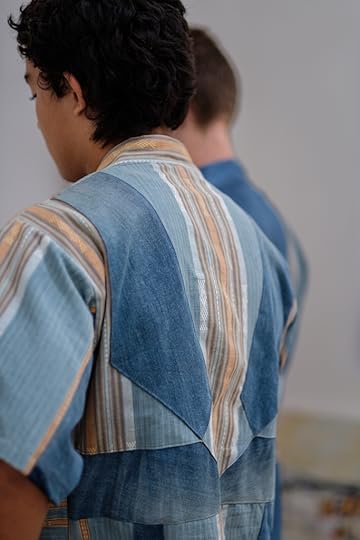The art of deconstructing and upcycling discarded garments in order to give them a rebirth
Whereas recycling waste materials, like discarded plastic or textiles, involves the process of breaking down by shredding or melting the cast-off products in order to create a moldable, usable basic material, upcycling implicates re-designing and improving discarded products, maintaining the essence or the core of the product. Consequently, the upcycling of a garment involves giving the discarded piece new life, or a rebirth.
Upcycling of unwanted garments makes particularly good sense, as the fashion industry is known as one of the most polluting industries in the world. Not least because many of the large mainstream brands operate with a business model that involves overproduction in order to avoid having to reorder more items of a potentially popular style, which, as a side note, leads to endless outlets that continuously undermine the value of clothes. In other words, it is more lucrative to produce too much than to run out of a popular style, even if this involves having to throw away or burn the surplus stock, which says a lot about the cost of work and production in the factories used as well as the price of virgin-materials. This notion implies that when talking about textile-waste we are not only dealing with the millions of tons of clothing that consumers worldwide throw away every year because they are done consuming them. We are also dealing with “un-consumed” clothes. Subsequently, it seems that there is an almost endless source of materials — deadstock or second-hand garments — for the design-practice of upcycling garments, which most certainly makes this a legitimate reason for designing “new” things.
 Reborn Kimonos from Southeast Saga
Reborn Kimonos from Southeast Saga Upcycling often includes redesigning or improving functioning garments or garments that are in good shape, but have been discarded due to perceived obsolescence, shifting trends, or overproduction. The majority of garments that are discarded are not worn out—maybe they have been used just a few times, or maybe they have never been used at all—they are just no longer timely and trendy. The act of upcycling garments—as well as other things for that matter—provides the sustainable designer with a creative dogma that can provide direction and beneficial limitations in the design process.
The upcycling dogma goes somewhat like this: only discarded garments or fabrics can be used, and the overall purpose is improving the quality of the cast-off products. The latter is important. The word upcycling contains an inherent appeal to upgrade, develop, and recover something that has been rejected, and hence an appeal to prolong its lifespan. In the book The Upcycle (McDonough and Braungart: 2013) one of the chapters is initiated by a very telling anecdote:
In Akira Kurosawa’s film Dersu Uzala, a group of travelers sets out to survey a region of harsh, wintery Siberian forest, territory impossible for them to navigate on their own. They encounter Dersu, a wise nomadic tribesman who knows the area and agrees to serve as a guide. During a storm, Dersu leads the group to a hut in the forest. Dry wood has been laid there already, left behind by the last visitor. Because of the previous visitor’s fore- thought, the travelers can light a fire and warm themselves in the devastating cold. When the group is ready to leave the hut, Dersu is astonished to discover they would do so without stocking a new supply of dry firewood for the next person seeking shelter. How could they think of doing that? Why would anyone do such a thing? From Dersu’s perspective the travelers should leave the place as the found it—in fact, better than they found it: upcycled.
Upcycling is about improving and enhancing. And, as the above quote beautifully captures, the act of upcycling includes an abundant mindset and a wish to add value to the world and improve lives. That is the core of upcycling.
The upcycling of things can involve mending worn out parts of an object or replacing damaged elements, but it can also imply more radical alternations of the original piece, or “hacks.” Upcycling hacks can be beneficially implemented into things that are perceived as obsolete due to their non-trendy look, which is often related to fashion. Hacking a discarded piece of clothing can implicate disassembling it into modules or fragments, and thereafter re-establishing it in a new manner.
 Reborn Kimonos from Southeast Saga
Reborn Kimonos from Southeast Saga The thought of disassembly is closely related to deconstruction; a term, which has its roots in postmodern, semiotic philosophy, and is linked to the French philosopher Jacques Derrida (1930–2004).
To deconstruct is not to destroy. Deconstructing implies undoing something, which, in the case of upcycling garments could be the undoing of the trend-related look that makes the garment appear obsolete. Deconstruction implies breaking something down into parts in order to gain a thorough understanding of the components it is made up of. In Derrida’s philosophy, deconstruction is however not related objects, and certainly not to fashion, but to philosophical texts. In his seminal work Of Grammatology Derrida closely examines and deconstructs the language and logic of various canonical texts by Plato, Rousseau, Kant, Hegel, and Nietzsche. The word grammatology means “the scientific system of writing,” and Derrida seeks to disclose the ambiguity and complexity of the texts he analyses. Briefly put, Derrida’s deconstructivism is built upon a need to understand in order to re-evaluate Western assumptions, truisms, and values linked to binary oppositions, which typically contain an inherent hierarchy that uncritically favors one over the other. Examples of such oppositions are structure versus creativity, masculine versus feminine, white versus black, etc.
Deconstruction involves determining what is “wrong” with a given text — or, in my usage of the term, a discarded product — and, in so doing, detecting whether it is characterized by poorly built-up arguments — badly made components or materials — or internal inconsistency and taken-for-granted assumptions — an unendurable composition, which makes the overall expression unsustainable — and finally potentially undoing these “errors” in order to reconstruct it.
In the case of upcycling garments, which have been discarded because they are experienced as obsolete, the process of deconstruction can involve identifying the “modules” or components of the garment that don’t work aesthetically on a long-term basis, due to the fact that they are trend-based and fleeting. Once the trend-based components of the garment have been uncovered, these should be removed or hacked — and hence, radically changed — after which point, the upcycling or upgrading of the garment into an anti-trendy, sustainable, long-lasting piece of clothing can materialize.

The process of uncovering the product elements that are perceived as obsolete has similarities with the process of eidetic reduction. Briefly put, eidetic reduction involves uncovering the core qualities of an object. In the case of upcycling and the process of eliminating the components in an object that don’t work aesthetically on a long-term basis, this method can help determining which parts to maintain and which ones to hack or remove in order for the object to still be perceived as usable and functional.
The process of upcycling should lead to an improved, well-functioning object that is aesthetically sustainable and resilient. Even if the upcycling process results in radical changes of the original object, the outcome should still be functioning, and it should be charged with aesthetic qualities that ensure longevity.
This is exactly where the process of eidetic reduction comes in handy; eidetic reduction can reveal the core of clothing or clarify what it takes for an object to be described as a garment. The outcome of the hack or upcycling might be asymmetrical or complex in its expression, and the design process might involve altering an object from being a shirt into being a dress, or from being trousers into being a skirt or a kimono, but while the trend-based, fleeting look should be removed, the core or the “garment-framework” should be preserved — it must still be wearable — and components that can ensure long-term aesthetic nourishment should be added. This could involve adding tactilely stimulating elements or visually intriguing features, or it could manifest in a cleanse of the overall expression and thus an emphasis of the beauty of simplicity.
No matter how the upcycling process manifests, the outcome should be an improved, well-functioning garment that can be used for various occasions or provide the wearer with flexibility, which could materialize in an adaptable fit that enables adjustments over time in order to accommodate bodily changes.
 Reborn Kimonos from Southeast Saga
Reborn Kimonos from Southeast Saga Deconstructivism is not only linked to language and logical argumentation in philosophical texts, it is also known as a postmodern architectural movement. This movement can be described as “anti-architecture” in the sense that it is characterized by distortion and fragmentation, as well as by deliberately stirring up the “common rules” of architecture. The result is characterized by fragmented constructions, and an absence of symmetry and harmony.
Similarly, the upcycling of clothes that used to be fashionable and now have been consumed and rejected might lead to “anti-design” in the sense that upcycled garments adhere to anti-trends rather than trends. Anti-trendy upcycled clothes might, in order to embody longevity, explore unpredictability and asymmetry, seeking to arouse the curiosity of the recipient and appeal to her/his wish to engage in visual and tactile explorations. An upcycled garment might be characterized by complexity and investigate the limits of what a piece of clothing can be and look like. The aesthetic receiver experience connected to it is characterized by being open and explorative.
The process of hacking discarded garments with the purpose of prolonging their lifespan and upgrade their value, which I am exploring in my writing and in Southeast Saga as a legitimation of designing new things in a world overflowing with unwanted stuff, can beneficially make use of the explorative design-principles from architectural deconstructivism.
The art of deconstructing cast-off apparel — that is still intact but is perceived as obsolete by the owner — involves pinpointing the trend-based part of the product that has made its existence transitory. In that sense, deconstruction can be described as a sort of reverse engineering of an item: it involves dissecting it or splitting it up into its core components (which eidetic reduction can help one do) and determining the trend-related, fleeting part of it, or the part or piece of it that doesn’t work anymore and makes it feel obsolete to the user. The obsolete part should then be removed, and the process of upcycling and rebirth can begin. This involves reconstruction with the aim of creating a long-lasting, sustainable new object. The part of a discarded piece of clothing that is perceived as obsolete might be its shape, its color or color combination, its trimmings, its fit, its silhouette, its composition, its material combination, or its texture. It might be related to its lack of flexibility or multifunctionality. Or, it might be linked to its blandness; if that is the case the notion on anti-design inspired by the architectonical deconstructivism might come in handy, which could involve working with asymmetry and distortion. Whatever the perceived obsolescence is associated with, it is most likely linked to the fleeting nature of fashion trends that dictate a new look multiple times a year.
Upcycled garments embody a new kind of luxury that revolves around creativity, uniqueness, and imperfections. Imperfections that radically upcycled garments express are not defects, and they don’t imply that something is malfunctioning. Upcycled garments are fully functional, imperfectly nourishing, challenging, and often asymmetrical.



